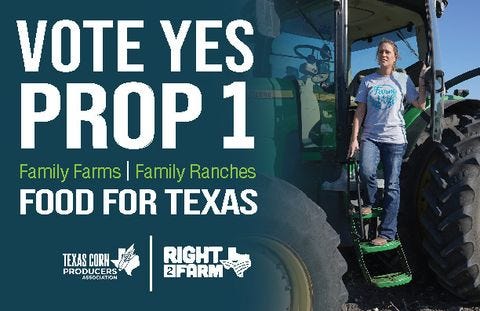'Right to Farm' or 'Right to Harm', says FARFA
A "right to ranch/farm" is going to hurt the little guy.
The Big Valley may not just be a T.V. show about a ranch anymore, it’s also a description of the gulf in information between what the public is hearing about Prop 1, which Texans will be voting on Tuesday, and what the public knows about the issue. Prop 1 is a proposed constitutional amendment that would create a right to ranch/farm in Texas. Ostensibly everyone, including the Texas Southwest Cattle Raiser’s Association to Texas Corn Producers, seems to be behind it.
Yet we are hearing almost nothing about the proposed law–– and that is always a bad sign.
The Farm and Ranch Freedom Alliance (FARFA) is one of only a few major associations of cattlemen in Texas that is opposing Prop 1. When we reached out to FARFA to find out why they opposed the law, they framed the problem this way, “The proponents of Prop 1 are using a real problem -- the overregulation of farms by cities -- as a way to push through protections for truly bad actors, who pose a threat to their communities and neighbors, including small farms.”
That begs the question ‘what are these bad actors doing?’ FARFA identified one situation that has become all too common in the Texas Panhandle, “manure lagoons”. Manure lagoons are exactly what they sound like, they are ponds where cattle feces–– usually from feedlots–– are aggregated. Feedlots are an industrialized process for raising cattle and involves hundreds (sometimes thousands) of cows living together in close proximity. Rather than allow the feces to slowly decay and fertilize the place it landed, the volume of feces produced by feedlots requires it to be concentrated in lagoons.
At times this has produced stories about fecal fog arising from feedlots in the panhandle and this commonly circulated image of a feedlot in Dalhart.
For clarity, the reddish color of the lagoon is not produced by blood, as cattle are not processed on feedlots. The reddish hue is likely produced by a combination of feces mixing with algae blooms and pesticides.
FARFA noted that the existing statute which created a right to the ranch in the 1980s is less far-reaching than the proposed constitutional amendment, yet it has produced situations where small farmers have little recourse against irresponsible feedlots whose manure lagoons overflow during storms and damage neighboring property. It is foreseeable that Prop 1 (if passed) would only exacerbate issues with feedlots.
Further, what exactly constitutes a right to ranch won’t be determined in the legislature or in a public setting where ranchers can help develop the legal framework that is supposedly going to help them. Rather, the newly enhanced right to ranch will be amorphously defined by “generally accepted practices" which will be determined in a manual created by unelected bureaucrats at Texas A&M.
However, FARFA does join in the universal acknowledgment of a need for change in farming/ranching regulation, noting that the current legal regime of “city regulation” allows localities to arbitrarily discriminate against farms by overregulating them into oblivion. FARFA explained in other statements on Prop 1 that cities try to bully farms out of existence, “Local governments in particular often weaponize zoning laws to drive out small farms because they don’t think agriculture belongs in their cities or towns.”, but the alliance noted in an email to Cowtown Caller that “There are ways to address the abuses of cities without going nearly this far.”
Indeed, FARFA is correct again on this. FARFA made no official recommendations on how to correct the abuses of cities but there are a number of things the state could do to help farmers who are being bullied by regulators. One solution may include raising the legal standard for when a locality can impose certain types of regulations on ranches/farms to a “narrowly tailored” and “compelling state interest” standard.
This would require a city to establish a heightened interest in regulating a ranch and also to do so in the least invasive way possible. A legal standard like this could be more likely to find a happy medium that is above the standard that is currently too low and favors the cities but could also become too high after Prop 1, over-favoring bad actors in agricultural and livestock production.
FARFA has characterized Prop 1 as “the right to harm” on their website, and indeed they are right. It is clear that when readers head into the polling booths on Tuesday, they should vote “no” on Prop 1.





